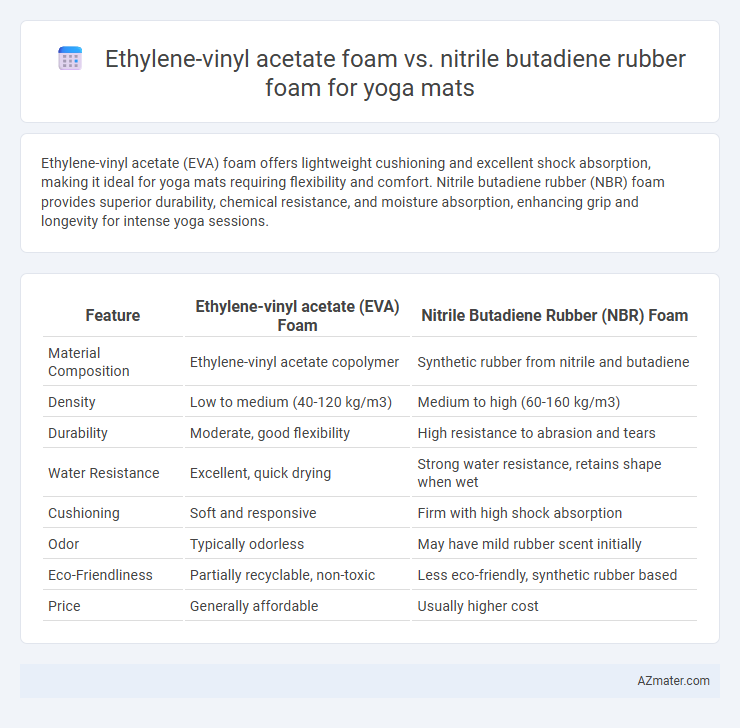Ethylene-vinyl acetate (EVA) foam offers lightweight cushioning and excellent shock absorption, making it ideal for yoga mats requiring flexibility and comfort. Nitrile butadiene rubber (NBR) foam provides superior durability, chemical resistance, and moisture absorption, enhancing grip and longevity for intense yoga sessions.
Table of Comparison
| Feature | Ethylene-vinyl acetate (EVA) Foam | Nitrile Butadiene Rubber (NBR) Foam |
|---|---|---|
| Material Composition | Ethylene-vinyl acetate copolymer | Synthetic rubber from nitrile and butadiene |
| Density | Low to medium (40-120 kg/m3) | Medium to high (60-160 kg/m3) |
| Durability | Moderate, good flexibility | High resistance to abrasion and tears |
| Water Resistance | Excellent, quick drying | Strong water resistance, retains shape when wet |
| Cushioning | Soft and responsive | Firm with high shock absorption |
| Odor | Typically odorless | May have mild rubber scent initially |
| Eco-Friendliness | Partially recyclable, non-toxic | Less eco-friendly, synthetic rubber based |
| Price | Generally affordable | Usually higher cost |
Introduction to Yoga Mat Materials
Ethylene-vinyl acetate (EVA) foam and nitrile butadiene rubber (NBR) foam are two popular materials used in yoga mats, each offering distinct properties that affect performance and comfort. EVA foam is lightweight, flexible, and provides good cushioning with moderate durability, making it suitable for beginners and light practice. NBR foam offers superior density, excellent shock absorption, and resistance to moisture and chemicals, favored by practitioners seeking durability and enhanced support during intense sessions.
Overview of Ethylene-Vinyl Acetate (EVA) Foam
Ethylene-vinyl acetate (EVA) foam is a lightweight, flexible material known for its excellent cushioning, shock absorption, and resistance to moisture, making it highly suitable for yoga mats. Its closed-cell structure provides durability and a soft, non-slip surface that enhances user comfort during yoga practices. Compared to nitrile butadiene rubber (NBR) foam, EVA offers superior water resistance and lighter weight, contributing to better portability and ease of cleaning.
Overview of Nitrile Butadiene Rubber (NBR) Foam
Nitrile Butadiene Rubber (NBR) foam is a durable, oil-resistant material commonly used in yoga mats for its excellent cushioning and resilience. Its closed-cell structure provides superior shock absorption and moisture resistance compared to Ethylene-vinyl acetate (EVA) foam, enhancing grip and hygiene. NBR foam also offers better resistance to wear and tear, making it suitable for high-intensity yoga practices requiring long-lasting performance.
Key Physical Properties Comparison
Ethylene-vinyl acetate (EVA) foam offers lightweight cushioning with excellent flexibility and good resistance to UV radiation, making it ideal for yoga mats requiring comfort and durability. Nitrile butadiene rubber (NBR) foam provides superior chemical resistance, higher density, and enhanced compression set recovery, resulting in better resilience and longevity under heavy use. Key physical properties such as tensile strength, water absorption, and thermal stability distinguish EVA's soft, closed-cell structure from NBR's tougher, oil-resistant characteristics, influencing mat performance in different environmental conditions.
Cushioning and Comfort Differences
Ethylene-vinyl acetate (EVA) foam offers superior cushioning with excellent shock absorption and a lightweight, flexible structure ideal for yoga mats, enhancing user comfort during extended sessions. Nitrile butadiene rubber (NBR) foam provides denser, more resilient cushioning that retains shape under pressure and offers enhanced durability and moisture resistance, making it suitable for high-impact yoga practices. EVA foam excels in softness and flexibility, while NBR foam prioritizes firmness and longevity, influencing comfort preferences based on yoga style intensity and user needs.
Durability and Longevity
Ethylene-vinyl acetate (EVA) foam offers excellent durability and resilience, resisting cracking and deformation under frequent use, making it ideal for yoga mats that endure daily stretching and impact. Nitrile butadiene rubber (NBR) foam provides superior longevity due to its high resistance to oils, solvents, and abrasion, ensuring prolonged mat integrity in various environmental conditions. While EVA foam excels in lightweight flexibility, NBR foam's enhanced durability against mechanical wear and chemical exposure often results in a longer-lasting yoga mat.
Slip Resistance and Safety
Ethylene-vinyl acetate (EVA) foam offers excellent slip resistance due to its closed-cell structure, providing a firm grip on various floor surfaces essential for yoga practice safety. Nitrile butadiene rubber (NBR) foam also delivers strong slip resistance but excels in cushioning and durability, reducing the risk of injury during intense sessions. Both materials enhance safety, but EVA foam is typically preferred for superior traction, while NBR foam is favored for impact absorption and longevity.
Environmental Impact and Sustainability
Ethylene-vinyl acetate (EVA) foam is widely used for yoga mats due to its lightweight and cushioning properties, but it poses environmental challenges as it is derived from petroleum and is non-biodegradable, contributing to landfill waste. Nitrile butadiene rubber (NBR) foam offers improved durability and resistance to oils and chemicals while also being synthetic and non-biodegradable, although some manufacturers are moving towards more sustainable production methods to reduce its carbon footprint. Both materials have limited recyclability, but innovations in bio-based alternatives and closed-loop recycling systems are essential to enhancing the environmental sustainability of yoga mats.
Price and Value Analysis
Ethylene-vinyl acetate (EVA) foam yoga mats generally offer a lower price point compared to nitrile butadiene rubber (NBR) foam mats, making them attractive for budget-conscious consumers. EVA foam provides lightweight cushioning and good durability but may lack the high resilience and chemical resistance found in NBR foam, which justifies NBR's higher cost with superior sweat resistance and longevity. Considering long-term value, NBR foam mats often deliver enhanced comfort and durability, making them a preferable choice for frequent practitioners despite the initial higher investment.
Choosing the Right Foam for Your Yoga Practice
Ethylene-vinyl acetate (EVA) foam offers lightweight cushioning with excellent shock absorption, making it ideal for gentle yoga practices that require comfort and flexibility. Nitrile butadiene rubber (NBR) foam provides superior durability, higher density, and resistance to moisture, which benefits practitioners who prefer a firmer, more supportive surface and engage in high-intensity or hot yoga sessions. Selecting EVA foam suits those prioritizing lightweight and soft comfort, while NBR foam is better for durability and moisture control during intense workouts.

Infographic: Ethylene-vinyl acetate foam vs Nitrile butadiene rubber foam for Yoga mat
 azmater.com
azmater.com